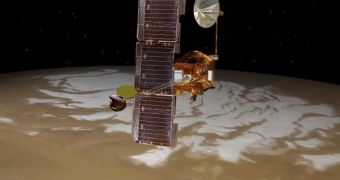Experts operating the NASA Mars Odyssey orbiter say that the first days of the new listening campaign for radio signals sent by the Phoenix lander have yielded no results. The space agency is hopeful that the spacecraft which landed on the Red Planet in 2008 will be able to use its built-in Lazarus mode to reactivate its systems, and then eventually resume science operations. The high latitude at which it is located on the planet's surface means that only now the amount of sunlight its solar panel receive is theoretically sufficient to restore power to the spacecraft. NASA communicated with Phoenix last on November 2, 2008, experts at the Jet Propulsion Laboratory (JPL), in Pasadena, California, report.
Though they are painfully aware that the lander may never recover, NASA experts decided to take their chances, and diverted the Odyssey orbiter from its regular scientific observations for a few days, so as to scan the area where Phoenix landed. They hope that, if the observations station managed to restore its power level, it will emit radio signals, that the orbiter could then pick up and forward to Earth. The same approach, to use orbital instruments as relays, was also used for the rover Spirit. Its signals were routed through the NASA Mars Reconnaissance Orbiter (MRO), and so the rover no longer had to use its high-gain antenna for direct Earth communications. This saved a lot of energy for other tasks.
The first Odyssey listening campaign was conducted for a few days in January. The search was without success, but experts said at the time that, if Phoenix were to awake, the chances of that happening would increase during later months. The new campaign, which started on Monday, February 22, is the second attempt in a row of three. The last one will be conducted in early April. If results from all three are inconclusive, then NASA will give up its attempts to revive Phoenix. While the Odyssey is surveying the lander's location, it also loses valuable observations time, and the space agency is not willing to trade this over other tasks for too long.
“Phoenix […] operated successfully in the Martian arctic for about two months longer than its planned three-month mission. The season at the Phoenix landing site is now mid-springtime, with the sun above the horizon for roughly 22 hours each Martian day. That is comparable to the illumination that Phoenix experienced a few weeks after completing its three-month primary mission. Phoenix was not designed to withstand the extremely low temperatures and the ice load of the Martian arctic winter. In the extremely unlikely event that the lander has survived the winter and has achieved a stable energy state, it would operate in a mode where it periodically awakens and transmits a signal to any orbiter in view,” JPL experts say.

 14 DAY TRIAL //
14 DAY TRIAL //